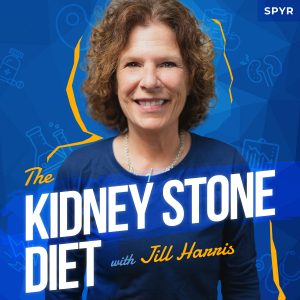In this episode of the Kidney Stone Diet Podcast Jill explains how to read nutrition labels when you’re at risk for kidney stones.
Jeff Sarris
Welcome back to the Kidney Stone Diet Podcast, the show about reducing your risk for kidney stones and living your best life. I’m your host and fellow student, Jeff Sarris, and I’m here, as always, with our resident nurse and professional kidney stone expert, Jill Harris.
Jill Harris
Well, hello, Jeff, how are you?
Jeff Sarris
I’m good. It’s always good to see you. This is good to see, you know, the day of getting a bunch of podcast episodes in and I know you were working on some, I don’t wanna say secret, but there’s some exciting stuff that we’re going to be launching in the coming months.
Jill Harris
Yes, I’m very excited. Although, as all of my patients know, I have been resistant to doing this for a long time. And they’re like Jill plays make us some recipes, we need to figure out what we can eat what we can make bah, bah, bah. So yes, I’m in the middle of cooking really simple recipes for kidney stone patients. And by the way, they’re just healthy recipes for everybody. These are things that I eat, and we’re getting them all together. And I’m glad that my patients have pushed me to do it. Because it’s been a lot of fun taking the pictures, writing the content for it, tweaking recipes, so they’re kidney stone compliant. It’s been great fun. I’m very grateful to my patients for sure.
Jeff Sarris
Yeah, for sure. And, it is just going to be able to help so many more people with this because that is a big question. What can I eat? The what can’t I eat is almost the easy part. And then it’s like, okay, there’s other stuff. But where do I go from here?
Jill Harris
Exactly. Look, when somebody is asking you to change your diet, no matter what you have, it’s so overwhelming. So many people come to me and my heart always feels so filled with empathy because, not only are they sick, but now somebody’s telling them to change their whole lifestyle. Well, really, how the hell do you do that without support, help, and compassion? And time, by the way, it takes a lot of time to teach people really how to do that. Because each person is so incredibly different with different medical conditions, sensitivities, food allergies, all of it, right?
Jeff Sarris
Yeah, it’s gonna be exciting. So it should be coming out, hopefully, just a handful of weeks after this podcast comes out. But I think we’ll dive right into the topic for this week.
Jill Harris
What is the Jeff, what are you gonna throw at me right now?
Jeff Sarris
Yeah, we’re gonna look at nutrition labels, and how to actually read the packages of the products that we’re purchasing.
Jill Harris
All right, I love talking about nutrition labels. You know, I’m 57. And my generation was brought up, you look at fat and calories. That’s it. You don’t need to know nothing about anything else. So that’s all you need to know. And so there’s a lot of people my age who get kidney stones, so they’re not trained to look at anything but calories and fat. So, there’s so much more to a nutrition label than that.
When you’re looking at a nutrition label. First of all, hold on, hold on…I’m screaming about this all the time on my Facebook page. When you’re at the grocery store, don’t be looking at something like this. You’re looking at the front of the label. Oh, no sugar. This is gonna make me skinny mini 100% heart, bla, bla blue, all this kind of stuff. Your husband’s gonna love you again. Oh, by me. That’s what the front of the label says. Okay. But then when you turn it around, you’re like, well, I’m gonna ask you guys, are you turning it around? Because most of you aren’t. You look at the front of the label, because the food marketing people know exactly what you want right now. They know you want no added sugar. Okay? They know you want gluten free, even though most of you ain’t even gluten sensitive. Low cal, if the word skinny is on it, guess who’s buying it? Most of you. Okay, skinny don’t mean nothing.
Now, instead of just reading the front of a package, turn it around Buster Brown. Look at your nutrition label. You can look at calories—I do. That’s part of that nutrition label. Also, before you look at anything else, look at the serving size. Look at that serving size. It matters. First of all, did you know that the serving size is really not what’s recommended for you, but it’s what most people eat? This is what I’ve read. I push back on that because Ben and Jerry’s, they say that there’s four servings in that little pint. I beg to differ. You’re having a shitty day that’s one serving. Okay, we all know that’s true. But look at the serving size, then look at the rest of the stuff. Okay?
So you want to look at calories, that’s important. If you overeat calories, you will gain weight. If you eat less calories, you will lose weight. Typically. Unless you have other things going on. Look at the serving size. Look at the fat. Look at the saturated fat. That’s what you really want to know—how much saturated fat is in there. For people who are on keto, God bless you, do your thing. But that’s just something to know. Okay, you want to look at how much fiber is in your product, you want to look at how much sugar is in your product. And then underneath, all the labels have changed, added sugar is now parsed out. That’s really what you want to focus on. If there’s a lot of added sugar in that product, you may not wanting to purchase it. Okay.
The other things you want to look at, you want to look at calcium, that’s always on the bottom. You want to look at your protein. For diabetics, you want to pay attention to protein, you want to pay attention to potassium, you want to pay attention to things like that. You want to pay attention to sodium. If a product is gluten free, it typically has more sugar, and salt because once you take away the gluten, it’s going to taste el crappo. So they stuff it with more sugar and salt. If it’s a gluten-free, low-sugar product, there’s gonna be a heck of a lot of sodium in it.
So notice that on the kidney stone diet, one of the two elements of it, very important, lower sodium—1500 milligrams to 2000 milligrams a day—and low added sugar—25 grams of added sugar for women 38 grams of added sugar for men—that adds up quickly. Look at your yogurts. Don’t be looking at the front of the yogurt package and say, “Oh, it’s yogurt. Delicious.” Turn it around, how much sugar is in that? I bet you snicker bars has less. So look at it. Look at your labels. If it were up to me, what I would really want you to look at, sugar and salt. That’s what I would want you to look at. And next after that, calcium. Notice, there’s a lot of products that you think have calcium in it and they don’t. So notice the calcium level. Calcium was annoying because it was always written as a percentage. So, now the nutrition labels have changed, they’re a lot clearer for consumers. Calcium is now written in milligrams so you can see it clearly.
The other thing, like I said, they parsed out added sugar, that’s a big change that the food people didn’t want to happen. But the government wanted that to happen because diabetes, heart attacks, right? So sugar is something that we really need to limit because it affects every organ in our body, fatty liver disease, all of it. So that’s very important.
So I guess if it were up to me, the biggest things if you’re eating a product, typically, that’s lower in sugar and lower in salt, it’s going to be a relatively healthy product like a vegetable or a fruit. So, I’ll say this too Jeff and then you can cut me off…
“Well, Jill, what about fruit? It’s high in sugar.” It’s not added, God put it in there. “All right, well, God didn’t put sugar in honey, but you’re considering that’s added?” Yes, because honey is typically in the ingredient list so it’s added into the product. Not all manufacturers had to change their labels, so some labels may not be parsed out to show the added sugar. If you want to know if there’s added sugar in there, please look at your ingredient list. It tells you everything, so the nutrition label everything. Go downstairs, after the label, and look at all the ingredients.
Now, if there’s anything that ends with an ohss if you see brown sugar, brown syrup, molasses, honey, all that is extra, brown rice malt, all kinds of junk, and they use it so it’s a little sneaky, you don’t realize that’s sugar. Okay.
Now, that being said, everybody, I always watch my calories, so I have some products, and you will see them in my recipes, where it’s no-sugar-added maple syrup and you may say “Oh look at it you sister. You’re miss health nut. There’s a lot of junk in that ingredient list.” And so they put artificial things in there to make it a zero calories, zero sugar food. So, I will put a BIP, not a boop, a bip—a little bit—to give a sweetness to the food I’m eating.
So why I’m telling you that is that I’m always transparent. My patients know exactly what I do. But the other reason I’m telling you that is I am not expecting everybody who listens to me to have organic 100 million dollar flour. You know what I’m saying? So what if you want artificial sugar sometimes, I really don’t care about that. If you’re having it every day in huge quantities, you may want to rethink that. But sometimes you you want to aim for it’s good enough. And maybe your biggest thing is you really need to cut down on sugar right now. But you’re an addict, and you’re a diabetic and you’re overweight. You may have to use a sugar substitute sometimes—I don’t care. It’s not a big deal. Okay. All right. I digress. You know, I always do, Jeff.
Jeff Sarris
No, I mean, that’s really good. We can rewind for a second, go back to where you talked about replacing things with sugar and salt. I mean, low fat, most low fat products, it’s the same thing. It’d be like cardboard without a bunch of sugar and salt.
Jill Harris
You weren’t alive back then cuz you’re a baby. We were all chowing on SnackWell’s. Okay, so a snackable cookie was zero fat. But nobody ever paid attention to sugar because nobody was talking about that. So what does that mean? Like what we do now with kale and spinach and almonds—when someone says, “Oh, it’s low this, WEEEE!”, we didn’t have two SnackWell’s, we had a whole row. So you know, people overdo it. When somebody says that it’s healthy for you, “We just eat as much as we want, right?”
Jeff Sarris
So it’s important to actually look then. Just seeing those catchphrases, the marketing jargon on the front, doesn’t tell you the whole picture. So actually, I wanted to ask one more thing, because you have something like orange juice, that wouldn’t have added sugar, but it’s missing all the constituent components of the orange, how does that play out with your approach?
Jill Harris
So I love your question, you always ask great questions. Here’s the deal. So I wouldn’t suggest that diabetics try to get their calcium from orange juice because it is very high in regular sugar, even regular sugar because it’s all concentrated, right? And so you’re taking out all the pips, so there’s no fiber in it either. So, right, you’re just getting a shotright to your arteries with sugar. Personally, I wouldn’t drink orange juice, but some people use it for their calcium. Here’s the Rub, though. If you look at Orange juice in the grocery store, and even though I don’t drink it, I look at it, because it’s what I do for a living and I have to teach patients about it. If you look at it, vegans will use orange juice as a source for calcium. But the darn thing is, the lower sugar ones tend not to have any calcium in them. The ones that they put calcium in, tend to be the full sugar ones. So it’s kind of annoying. You have to look around. That’s been my experience with it. That’s why I always say, after 30 years of eating healthy, whenever I see a new product, I always turn it around. It’s not like I’m above fooling myself. I’ve definitely brought stuff home and go “Oh my god, how did I not turn it around?” You have to do it with every product. And orange juice is one of those things. Like I said, yogurt is one of those things. Look at mustard. Look at ketchup, so filled with salt, but you would never think of anything unhealthy in those condiments. Why do you love them? Because they’re salty. That’s why, and sugary, by the way. So yes, orange juice is a great example.
Jeff Sarris
And, with juicing too, a lot of times people have a lot of weight loss. There’s a documentary called Fat, Sick, and Nearly Dead, I really enjoyed that one and it’s all about juicing. But a lot of times what people miss in the showcasing of juicing is how they took out the garbage and replaced it with juice. The taking out of the garbage is such a big part of these transitions. And, usually with a diet shift, that’s one of the major parts. So, you can almost go to anything to lose weight. And it’s like, all McDonald’s or whatever. But it doesn’t mean it’s better for you.
Jill Harris
I totally agree with that. And again, look, if somebody comes to me and they say “Jill, I’m going to continue drinking gin most of the day, and I’m still going to only use fast foods”, I’ll be like “Good, if that’s where you want to start, right on, but let’s just half the amount of what you’re doing. And guess what, you’ll be healthier. Okay?” Because you’re having less of it.
It comes down to a portion size. If somebody came to me, which they don’t, but if somebody wanted to quit smoking, I just be like, okay, just smoke less, you’ll be healthier until you don’t smoke anymore. The problem is always portion. Nobody’s gonna sell a Diet book talking about this, though. It’s not sexy. It’s not marketable. But that’s the truth. We need to watch our portion sizes. And we when we do treat ourselves, don’t let that make you go into a slippery slope where you can’t get yourself to stop eating. It’s all a fine line. I think that’s why diet is so confusing, and it’s overwhelming. We can’t fall for the marketing bull do, we really just have to be eating responsibly, looking at our labels, watching our portion sizes, eating a little bit of everything, and just reigning it in and knowing when to stop. I will always say that, we have to know when to stop. Don’t choose a diet that tells you you can have as much as you want of something. You’re going to get sick of that something, even bacon, people.
Jeff Sarris
I think that’s a good place to close out today. If you’re enjoying this podcast, be sure to check out the website, KidneyStoneDiet.com. Jill has the Kidney Stone Diet Prevention Course. She has a one-on-one consultation. There’s all sorts of free and premium content over there. You never have to spend $1. You can go get everything you need from there. There’s more episodes of the podcast. We have a bunch going on. And be sure to like, comment, and subscribe on this video, if you’re watching, or subscribe to the podcast on Apple Podcasts or Spotify or wherever you listen right now.
Jill Harris
Yeah, everybody, comment on YouTube because I love answering them. So do it people.
Jeff Sarris
And you are everywhere. You have the Facebook group with thousands of people you’re interacting with all the time. We have YouTube, the podcast, Instagram as well.
Let’s call that a wrap for today. Thanks again, Jill.
Jill Harris
Bye, Jeff. Thank you so much.














Leave a Reply